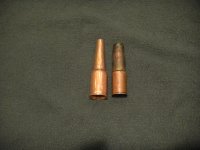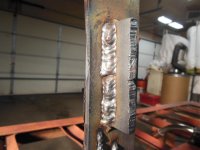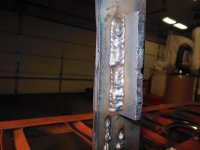Shield Arc
Super Member
Charts are like instructions, I only look at instructions when all else fails!:laughing:
First thing I think you need to do is turn the wire speed way down. Or the volts way up, but if you turn the volts up, you may not be able to handle the puddle.
When running wire feed vertical up, I build a shelf first. The width of the shelf determines the width of the bead. Once I have my shelf built I point the gun straight into the plate, or even slightly down. The whole time I let the puddle lay on this shelf I built. As you travel upwards, remember to raise your shoulder! Keep the gun angle consistent, and the arc length consistent, and your travel speed consistent! Move side to side, pause only long enough to let he puddle fill to the amount you want, then move quickly across the middle and pause on the other side long enough for the puddle to fill. Repeat as many times as necessary.
Here is a good video on welding vertical.
Mig Welding Techniques for uphill welding
First thing I think you need to do is turn the wire speed way down. Or the volts way up, but if you turn the volts up, you may not be able to handle the puddle.
When running wire feed vertical up, I build a shelf first. The width of the shelf determines the width of the bead. Once I have my shelf built I point the gun straight into the plate, or even slightly down. The whole time I let the puddle lay on this shelf I built. As you travel upwards, remember to raise your shoulder! Keep the gun angle consistent, and the arc length consistent, and your travel speed consistent! Move side to side, pause only long enough to let he puddle fill to the amount you want, then move quickly across the middle and pause on the other side long enough for the puddle to fill. Repeat as many times as necessary.
Here is a good video on welding vertical.
Mig Welding Techniques for uphill welding


